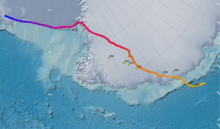South Magnetic Pole
The South Magnetic Pole is the wandering point on Earth's Southern Hemisphere where the geomagnetic field lines are directed vertically upwards. It should not be confused with the South Geomagnetic Pole described later.

For historical reasons, the "end" of a freely hanging magnet that points (roughly) north is itself called the "north pole" of the magnet, and the other end, pointing south, is called the magnet's "south pole". Because opposite poles attract, Earth's South Magnetic Pole is physically actually a magnetic north pole (see also North Magnetic Pole § Polarity).
The South Magnetic Pole is constantly shifting due to changes in Earth's magnetic field. As of 2005 it was calculated to lie at 64°31′48″S 137°51′36″E,[2] placing it off the coast of Antarctica, between Adélie Land and Wilkes Land. In 2015 it lay at 64.28°S 136.59°E (est).[3] That point lies outside the Antarctic Circle. Due to polar drift, the pole is moving northwest by about 10 to 15 kilometres (6 to 9 mi) per year. Its current distance from the actual Geographic South Pole is approximately 2,860 km (1,780 mi).[1] The nearest permanent science station is Dumont d'Urville Station.
| North Magnetic Pole[4] | (2001) 81.3°N 160.06°W | (2004 est) 82.3°N 113.4°W | (2007) 83.95°N 120.72°W | (2015) 86.29°N 160.06°W[3][5] |
| South Magnetic Pole | (1998) 64.6°S 138.5°E | (2004 est) 63.5°S 138.0°E | (2007) 64.497°S 137.684°E[6] | (2015) 64.28°S 136.59°E[3] |
Expeditions
Early unsuccessful attempts to reach the magnetic south pole included those of French explorer Dumont d'Urville (1837–40), American Charles Wilkes (expedition of 1838–42) and Briton James Clark Ross (expedition of 1839 to 1843).[7]
The first calculation of the magnetic inclination to locate the magnetic South Pole was made on January 23, 1838 by the hydrographer Clément Adrien Vincendon-Dumoulin, a member of the Dumont d'Urville expedition in Antarctica and Oceania on the corvettes "L'Astrolabe" and "Zélée" in 1837-1840, which discovered Adelie Land.
On 16 January 1909 three men (Douglas Mawson, Edgeworth David, and Alistair Mackay) from Sir Ernest Shackleton's Nimrod Expedition claimed to have found the South Magnetic Pole,[8] which was at that time located on land. [9]They planted a flagpole at the spot and claimed it for the British Empire. The three men began the expedition to the South Magnetic Pole in a motor car specially adapted for the cold conditions, but abandoned it when it proved useless on soft surfaces. They then walked a total of 1260 miles to reach the South Magnetic Pole while pulling sledges and supplies that weighed approximately 670 lbs. Walking on foot across the coldest place on earth was perilous, and the men faced many dangers such as falling in concealed snow crevasses and acquiring frostbite and snow-blindness. Fearing starvation, they strictly rationed their biscuits down to the crumbs, and hunted seals and penguins. However, there is now some doubt as to whether their location was correct.[10] The approximate position of the pole on 16 January 1909 was 72.25°S 155.15°E.[11]
Fits to global data sets
The South Magnetic Pole has also been estimated by fits to global sets of data such as the World Magnetic Model (WMM) and the International Geomagnetic Reference Model (IGRF).[1] For earlier years back to about 1600, the model GUFM1 is used, based on a compilation of data from ship logs.[12]
South Geomagnetic Pole
Earth's geomagnetic field can be approximated by a tilted dipole (like a bar magnet) placed at the center of Earth. The South Geomagnetic Pole is the point where the axis of this best-fitting tilted dipole intersects Earth's surface in the southern hemisphere. As of 2005 it was calculated to be located at 79.74°S 108.22°E,[13] near the Vostok Station. Because the field is not an exact dipole, the South Geomagnetic Pole does not coincide with the South Magnetic Pole. Furthermore, the South Geomagnetic Pole is wandering for the same reason its northern magnetic counterpart wanders. While the north magnetic pole began wandering very quickly in the mid 1990s, the movement of the south magnetic pole did not show a matching change of speed.
See also
References
- NOAA National Geophysical Data Center. "Wandering of the Geomagnetic Poles". Retrieved 10 October 2011.
- "Geomagnetism Frequently Asked Questions". NGDC. Retrieved 11 January 2009.
- British Geological Survey - Magnetic Poles
- "Geomagnetism, North Magnetic Pole". Geological Survey of Canada. Natural Resources Canada. Archived from the original on 26 March 2010. Retrieved 11 January 2009.
- World Data Center for Geomagnetism, Kyoto. "Magnetic North, Geomagnetic and Magnetic Poles". Retrieved 3 July 2012.
- "Poles and Directions". Australian Antarctic Division. 2011. Retrieved 11 October 2011.
- Antarctic Treaty System: an Assessment, p. 90, US National Research Council, 1986
- "FAQs from primary schools - British Antarctic Survey". Antarctica.ac.uk. 11 March 2011. Retrieved 9 November 2012.
- Antarctica: Great Stories from the Frozen Continent. Reader's Digest. 1985. pp. 178–179. ISBN 978-0949819642.
- "The Magnetic South Pole". Ocean Bottom Magnetology Laboratory. Woods Hole Oceanographic Institute. Retrieved 11 October 2011.
- Shackleton, Roland Huntford
- Jackson, Andrew; Jonkers, Art R. T.; Walker, Matthew R. (2000). "Four centuries of geomagnetic secular variation from historical records". Philosophical Transactions of the Royal Society A. 358 (1768): 957–990. CiteSeerX 10.1.1.560.5046. doi:10.1098/rsta.2000.0569.
- "Geomagnetism Frequently Asked Questions". Ngdc.noaa.gov. Retrieved 9 November 2012.
- Barton, Charles (2002). "Survey tracks current position of South Magnetic Pole". EOS. 83 (27): 291. doi:10.1029/2002EO000210.